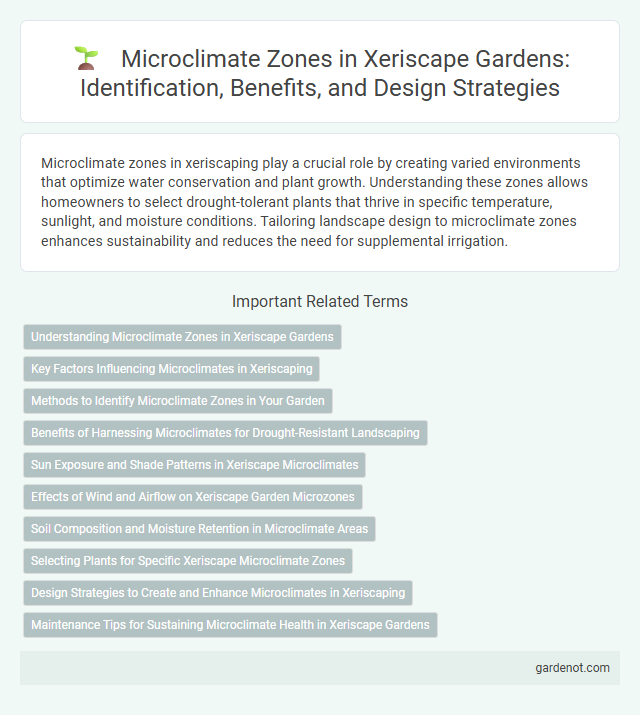Microclimate zones in xeriscaping play a crucial role by creating varied environments that optimize water conservation and plant growth. Understanding these zones allows homeowners to select drought-tolerant plants that thrive in specific temperature, sunlight, and moisture conditions. Tailoring landscape design to microclimate zones enhances sustainability and reduces the need for supplemental irrigation.
Understanding Microclimate Zones in Xeriscape Gardens
Microclimate zones in xeriscape gardens refer to distinct areas within a landscape where temperature, humidity, sunlight, and wind exposure create unique environmental conditions. Understanding these zones helps optimize plant selection and placement, ensuring drought-tolerant species thrive with minimal irrigation. Effective use of microclimate knowledge enhances water conservation and promotes sustainable xeriscaping practices.
Key Factors Influencing Microclimates in Xeriscaping
Key factors influencing microclimates in xeriscaping include solar radiation, wind exposure, and soil composition. Solar radiation affects temperature and water evaporation rates, while wind exposure impacts moisture retention and plant transpiration. Soil composition determines water drainage and heat retention, crucial for selecting drought-tolerant plants in xeriscape designs.
Methods to Identify Microclimate Zones in Your Garden
Identify microclimate zones in your garden by observing sunlight exposure patterns and measuring soil moisture levels throughout the day. Utilize tools like thermometers and moisture sensors to gather precise data on temperature fluctuations and hydration differences within various garden sections. Mapping these zones helps tailor plant selection and irrigation strategies to optimize xeriscape efficiency and promote sustainable water use.
Benefits of Harnessing Microclimates for Drought-Resistant Landscaping
Harnessing microclimate zones in xeriscape gardening enhances drought-resistant landscaping by optimizing water efficiency and plant health. By identifying areas with varying sunlight, wind, and soil moisture, gardeners can select suitable drought-tolerant species that thrive under specific conditions. This targeted approach reduces irrigation needs, conserves resources, and promotes sustainable, resilient landscapes.
Sun Exposure and Shade Patterns in Xeriscape Microclimates
Sun exposure and shade patterns critically influence xeriscape microclimates by determining soil moisture retention and plant water needs. South-facing slopes typically receive intense, prolonged sunlight, increasing evaporation rates and necessitating drought-tolerant species selection. Shaded areas, such as those under trees or structures, create cooler microclimates that support moisture-loving xeric plants and reduce irrigation frequency.
Effects of Wind and Airflow on Xeriscape Garden Microzones
Wind patterns and airflow significantly influence xeriscape garden microclimates by affecting soil moisture evaporation rates and plant transpiration. Strategic planting and the use of windbreaks can mitigate harsh winds, creating protected microzones that improve water retention and plant health. Understanding these microclimate variations helps optimize irrigation efficiency and enhances the resilience of drought-tolerant xeriscape plants.
Soil Composition and Moisture Retention in Microclimate Areas
Soil composition plays a crucial role in determining moisture retention within microclimate zones, influencing xeriscape success by supporting drought-tolerant vegetation. Sandy soils with low organic matter typically drain quickly, while clay and loam soils retain moisture longer, promoting plant resilience in arid conditions. Enhancing soil with organic amendments improves its water-holding capacity, optimizing microclimate areas for sustainable xeriscaping.
Selecting Plants for Specific Xeriscape Microclimate Zones
Selecting plants for specific xeriscape microclimate zones involves understanding temperature variations, sunlight exposure, and soil conditions unique to each zone. Drought-tolerant species like agave, lavender, and desert marigold thrive in hot, arid microclimates, while native shrubs and grasses perform well in slightly cooler or shaded xeriscape areas. Tailoring plant choices to microclimate characteristics enhances water conservation, plant health, and overall landscape sustainability.
Design Strategies to Create and Enhance Microclimates in Xeriscaping
Design strategies to create and enhance microclimates in xeriscaping include strategic placement of shade trees, windbreaks, and water features to regulate temperature and moisture levels. Incorporating diverse plant selections with varying heights and textures maximizes shading and evapotranspiration effects, reducing heat stress. Utilizing hardscape elements like rocks and permeable pavements helps retain soil moisture and moderate ground temperature, optimizing water conservation in arid landscapes.
Maintenance Tips for Sustaining Microclimate Health in Xeriscape Gardens
Maintaining microclimate health in xeriscape gardens requires regular monitoring of soil moisture levels and selective pruning to optimize airflow and sunlight exposure, promoting plant resilience. Incorporate organic mulch to stabilize soil temperature and retain moisture, reducing water evaporation and weed growth. Periodic assessment of plant health and microclimate conditions ensures adjustments in irrigation and shading strategies, sustaining the ecosystem balance essential for xeriscape success.
Microclimate zone Infographic

 gardenot.com
gardenot.com